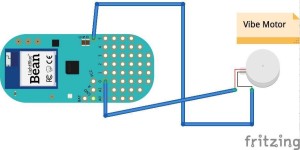When you hear the word “wearable”, what’s the first company you think of? Most likely your answer to the question is “Fitbit”, the $300 million dollar wearable company that just filed for an IPO. Fitbit has made their money by promising to improve your workout by tracking your heart rate and telling you how effective you’ve been. Though, how useful is information that someone would have to teach you how to use? Wearables should compliment and improve our current workout routines, not force us to adopt an entirely new behavior. That was our thinking when we designed “Repman”, a rep tracking wristband.
Repman is a wristband that uses accelerometers to count your reps as you go and vibrates when you’ve finished your set. There is no need to interact with an app or apple watch, just simply press the button and begin your workout.
The wristband works by collecting Y acceleration data from the Light Blue Bean. It first smooths the data using a smoothing filter found on the Arduino website. It then uses an algorithm to detect peaks in the data and counts each peak as a rep. It discards any rep that is too close too another, interpreting it as noise. The code and circuit diagram can be found here:
]]>
